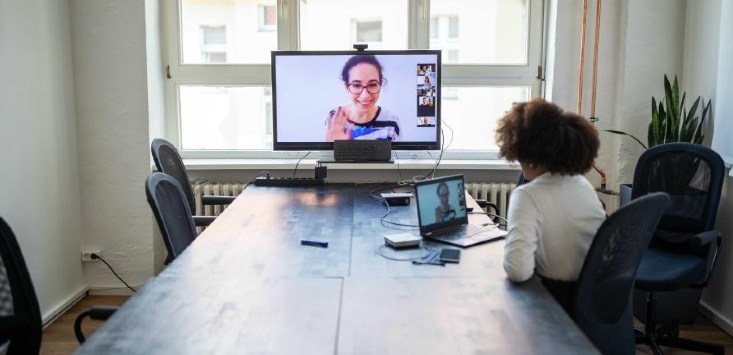
Source: Getty.
It’s official. Zoom fatigue is a real thing, and women suffer from it more severely than men.
In the first ever large-scale research examining the full extent of Zoom fatigue, academics from Stanford University found that women report feeling more tired than men following video calls.
What is to blame? It may very likely be the “self-view” display.
The new Stanford study reveals how the shift from in-person meetings to online ones has taken its toll more intensely among women. According to the data, Zoom fatigue — being the exhaustion that comes from a day of online meetings — is far greater for women than for men.
The evidence showed that one in seven women compared with one in 20 men reported feeling “very” to “extremely” fatigued after Zoom calls.
The latest findings coincide with a paper the Stanford researchers recently published in the journal Technology, Mind and Behaviour, which looked at the reasons people feel exhausted following video conference calls.
The latest study proves which cohort in society feel the strain most intensely — yet again, it’s women. The study surveyed 10,322 participants between February and March this year, using their “Zoom Exhaustion and Fatigue Scale” to secure greater understanding of the differences of exhaustion due to the extended use of video conferencing technologies during the past year.
Jeffrey Hancock, a professor of communication at the School of Humanities and Science, believes the findings contribute to a growing understanding of how the COVID-19 pandemic is disproportionately affecting different groups of people.
“We’ve all heard stories about Zoom fatigue and anecdotal evidence that women are affected more, but now we have quantitative data that Zoom fatigue is worse for women, and more importantly, we know why,” Hancock said.
“Self-focused attention refers to a heightened awareness of how one comes across or how one appears in a conversation.”
The biggest contributing factor to the feeling of exhaustion among women was an increase in “self-focused attention” set off by the self-view in Zoom.
Participants were asked questions including “During a video conference, how concerned do you feel about seeing yourself?” and “During a video conference, how distracting is it to see yourself?”
Women tended to answer the questions at higher rates than men, confirming prior research that found that women have a higher disposition towards self-focus than men when they are in the presence of a mirror.
“That prolonged self-focus can produce negative emotions, or what the researchers call “mirror anxiety,” Hancock said.
Women also felt tired by the continuous feelings of being physically “trapped” by the need to stay centred in the camera’s field of view, since video conferencing restricts one’s movement. Women also tended to have longer meetings than men and are less likely to take breaks between meetings, adding to their increased weariness.
“We see this gender effect across multiple different studies, and even after taking into account other factors. It’s a really consistent finding,” Hancock said.
Gender wasn’t only the only contributing factor to whether you experienced Zoom fatigue.
What kind of personality type you have also increased your likelihood of feeling weary. People who are more extroverted reported lower levels of exhaustion after a Zoom call compared to introverts.
People who were younger also reported higher levels of exhaustion compared with older research participants.
The colour of your skin could also determine how much Zoom exhaustion you felt. The researchers’ data found that people of colour reported higher levels of Zoom fatigue compared with white participants.
“We are working to understand what might be causing this race effect and develop solutions to address it,” Hancock said.
So, what are the possible solutions to this exhaustion?
Turn off your “self-view.” If you really need it on, move yourself away from the screen so you can move around without taking yourself off the screen.
The researchers also suggested that companies could organise meetings that are video-free, provide guidelines on how frequent and long meetings should be and specify more breaks between meetings.
You can also suggest no-video meeting days at your company, or have a day each week that does not require any video meetings.
This article was first published by Women’s Agenda.
Handpicked for you

Sound reliable, look relatable: Behavioural science hacks for video meetings



COMMENTS
SmartCompany is committed to hosting lively discussions. Help us keep the conversation useful, interesting and welcoming. We aim to publish comments quickly in the interest of promoting robust conversation, but we’re a small team and we deploy filters to protect against legal risk. Occasionally your comment may be held up while it is being reviewed, but we’re working as fast as we can to keep the conversation rolling.
The SmartCompany comment section is members-only content. Please subscribe to leave a comment.
The SmartCompany comment section is members-only content. Please login to leave a comment.